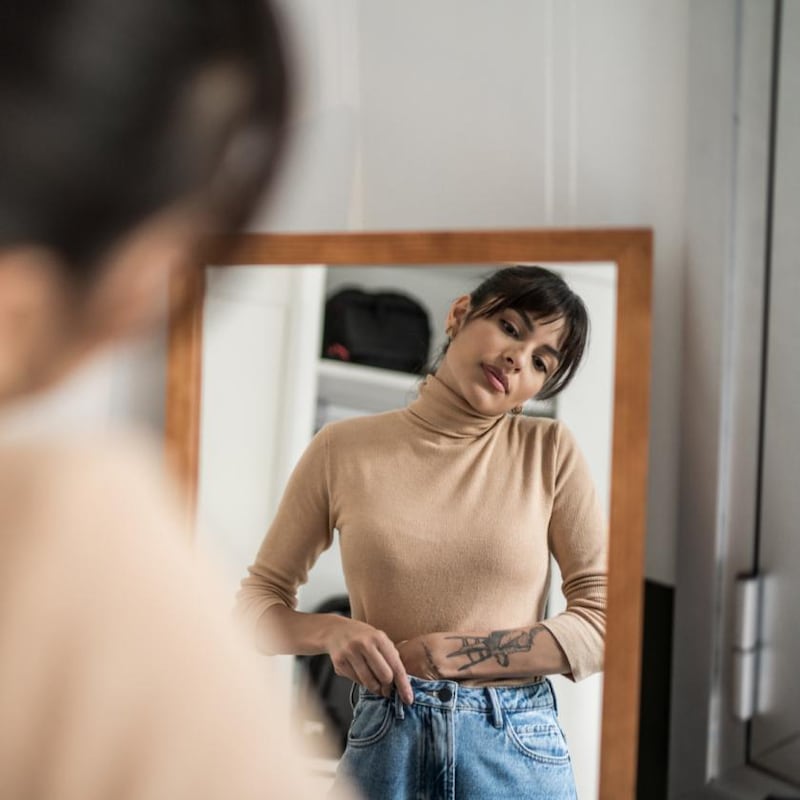The adage, try before you buy, may be more apt for clothes than any other product. No matter how typical your proportions are, most brands use a “fit model” – a person whose job it is to try on their clothes – with their own unique body shape, which is why we are all subject to confusing variances within clothing sizes.
Making sure something fits well is important for a long-lasting wardrobe, as poorly fitting garments can strain, stretch and ultimately break faster. Fit can also indicate how well something has been constructed, which is a good indication of its quality.
We’ll take you inside the fitting room and explain how a well-made garment will feel when you try it on.
Check the lining
When you’re about to put a garment on, the first thing you might notice is whether or not it is lined.
Depending on the garment, lining may or may not be necessary. Max Sanderson, a lecturer in fashion design at Parson's Paris, says "if it's a jacket for winter that's made of a fabric that will be uncomfortable against the skin, then lining is good". But a lightweight jacket for the summer will probably be more comfortable unlined.
If a garment is tailored, lining is extremely important. The owner of vintage consignment store Shop Bruce, Dan Neilsenbeck, says this is because "lining conceals a garment's construction and reduces strain, which increases its life".

Designer Bianca Spender says this can be applied to fitted garments more broadly. She says lining has an important role to play, taking some of the resistance off your movement, without pulling the outer fabric. But her "favourite silk dresses don't have lining because there is nothing like the feeling of silk against your skin".
On that note, it’s important to consider what the lining is made of. Sanderson recommends lining made from cupro, which is a cellulose fibre (like viscose), because it breathes but is also very durable, or silk because it is a protein fibre so it has good thermal properties. “If I saw something with polyester lining, I would be concerned that I would sweat in the garment and be uncomfortable because it doesn’t breathe,” he says.
Fill the pockets
Anyone who has worked in retail will tell you women get very excited when clothes have pockets. Unlike in menswear, where there are usually pockets in every conceivable location, womenswear often leave them off, which is frustrating. Pockets mean you may not need to carry a bag, and they can also improve the silhouette of trousers or the line of a dress.
The only thing more annoying than clothes without pockets is an insufficient pocket that can’t hold the weight of a phone. Sanderson says if you’re buying something you’ll be wearing regularly, you should make sure the pocket bag (the inside of your pocket) is made of durable fabric, like cotton or something heavier, so your keys, wallet or phone won’t tear a hole in it. It is even worth tucking your phone into a garment’s pocket while you’re trying it on, to make sure it doesn’t sag open or strain.
If the item is made of delicate fabric for a special occasion (like a tuxedo), a durable pocket bag might upset the way it sits, so a subtle pocket bag will have to suffice in these cases. This is similar for the breast interior pocket on a jacket, which will need to be discrete.
Get moving
A well-constructed garment should not restrict your movement. When you try something on, there are a few small moves you can do to test how the garment feels. Spender says to be sure “you can drive a car, get a book off the top shelf, and sit down on a chair without exposure or pulling”.
For a shirt, this might mean there is a square pleat in between your shoulder blades – this will allow more movement through the arms and body. Neilsenbeck says a good shirt will have a back yoke, which is the piece of fabric that runs from the back of your neck along your shoulders. He also suggests inspecting the buttons and buttonholes to ensure they’re well finished. If threads are already coming loose before a garment has made it out of the shop, the problem will only get worse when you bring it home.

For jackets, Sanderson says make sure “there is enough room under the arm” for it to be practical all day. “If you wear big sweaters all the time, is [the jacket] going to work with the size of the garments underneath?”
When trying trousers on, Spender says to check there are no creases on the crotch, and that the pants sit well on your body from all angles. Other things to look for in trousers are extra fabric in the hem and along the seams, so they can be made longer or let out a size if needed.
Generally, the way a garment hangs on the body can indicate how well it’s been made. “It really should fall from the shoulders without pulling or dragging into the neck, armhole and around the sleeves,” Spender says.
Think about your lifestyle
If you’re contemplating a dress or jumpsuit with a back zip, and you struggle to either undo or do it up on your own, will that be a problem? Perhaps you live with people who can help, but it might be worth considering if you’ll feel comfortable asking a stranger in a restaurant bathroom.
Or if you have small children, a puppy or a job that involves working in the garden or cooking, it’s probably not wise to buy a jacquard silk coat for day-to-day wear. Not least because you won’t be able to machine wash it.
Sanderson says it is important to consider what your day entails when you shop, to avoid buying clothes you'll never wear. "You don't buy a Maserati and drive it on the beach, so maybe you don't wear a silk coat to carry your groceries," he says. – Guardian









